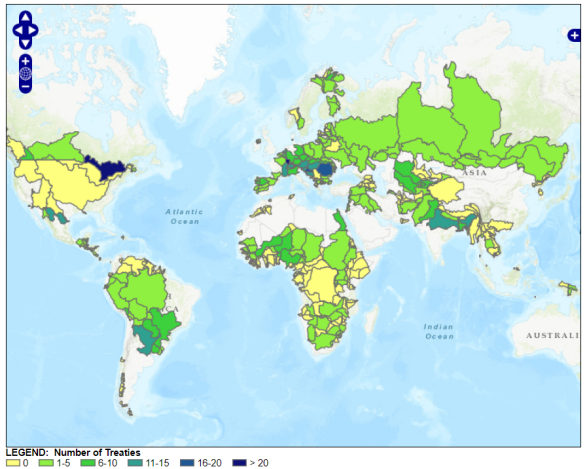Transboundary water cooperation crosses multiple levels of governance – global, regional, and basin-level legal and institutional frameworks and regimes. There is broad alignment of the norms of international water law that apply at each of these levels, with responsibility for implementing these legal rules at the national level. In addition to the formal rules of international water law, there is an emerging body of global governance standards, including quasi-legal, informal and voluntary codes of practice. These encompass such issues as water stewardship, hydropower development, and drinking water standards. This broad spectrum of frameworks contributes to the multi-level governance of transboundary water resources.
International water law provides an identifiable body of customary and treaty law that governs the uses of shared transboundary rivers, lakes, and aquifers. Two global UN instruments - the 1997 Convention on the Law of the Non-Navigational Uses of International Watercourses (in force from 2014) and the 1992 Convention on the Protection and Uses of Transboundary Watercourses and International Lakes (open to global membership from 2016) – offer guidance and best practices on how transboundary water resources can be managed. In addition to these global conventions, there are more than 400 international water law agreements across the globe. Further, the Second Progress Report on Transboundary Water Cooperation, published in 2021 on SDG Indicator 6.5.2 notes that, out of 153 countries sharing transboundary basins, 129 have submitted reports to the UN custodian agencies on their cooperative practice. (UN-Water).

Atlas of International Freshwater Agreements Source: http://gis.nacse.org/tfdd/
Transboundary agreements set out institutional arrangements for cooperation, management and protection of water resources and related ecosystems, as well as their enforcement and compliance. They generally include compliance facilitation mechanisms and dispute resolution mechanisms and help identify ways to share the benefits of water utilization, equitable water allocations and improved water-quality standards. They may also include provisions for joint monitoring, information exchange and public participation, as well as mutual assistance in case of extreme events. They might also include provisions for cost sharing arrangements for joint economic development activities (UN Report).
Institutions at national and regional levels are necessary for sustainable management of transboundary waters and for cooperation amongst riparian States. A clear mandate for national and transboundary organisations is important to create strong governing bodies. At the national level, where coordination between different ministries and water related institutions is needed, sufficient financing and political commitment is required.
The formation of joint bodies, such as river, lake and aquifer commissions, facilitate cooperation between the various governmental entities. Joint bodies provide the framework for integration between the different levels and for interaction between stakeholders such as local communities, NGOs, research institutions, private sector participants and donors. They are also a forum for data exchange, identification of pollution sources and exchange of information on existing and planned uses of water and conducting studies on climate change impacts. Rules of procedure and terms of reference for river basin organizations that consider specific local conditions are crucial. These rules should not only recommend the structure, responsibilities, rights and financial status of such organizations, but also ways and means to ensure public participation (UN Report).
IWLA research under this theme
Devlaeminck DJ & Huang X. China and the global water conventions in light of recent developments: Time to take a second look?. RECIEL. 2020;29:395–405.
Su Y. Evolving normativity in contemporary international water law: A communicative approach to the growing role of non-state actors. RECIEL. 2020;29:372–384
Wouters P, Vinogradov S. Reframing the transboundary water discourse: Contextualized international law in practice. RECIEL. 2020; 29:385–394.
Zhao Y., Xiong X., Wu S., & Zhang K. Protection of prior and late developers of transboundary water resources in international treaty practice: a review of 416 international agreements. International Environmental Agreements: Politics, Law and Economics. 2021.
![]() Tel: 86-027-68756726
Tel: 86-027-68756726
![]() Address: Wuhan University China Institute of Boundary and Ocean Studies (CIBOS), P.R. China,
Address: Wuhan University China Institute of Boundary and Ocean Studies (CIBOS), P.R. China,
© International Water Law Academy. All Rights Reserved.